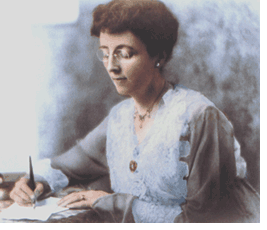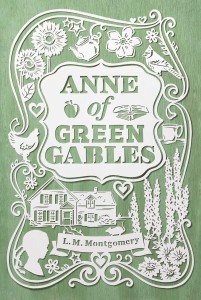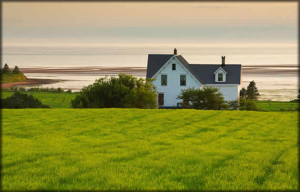By Maho Nishikawa
L. M. Montgomery (1874 – 1942), who was born on Prince Edward Island (PEI), Canada, is one of the most important writers in the Canadian literature scene. She is most famous for Anne of Green Gables, a novel that has sold more than 50 million copies and been translated into at least 20 languages. This internationally popular novel has also been adapted into films, musicals and even animated TV series. There are surely numerous elements that make the story interesting, but the most noteworthy points in Anne of Green Gables include: the strong connections between Anne and Montgomery, the lively personality of Anne and the descriptions of nature.
 Maud returned to Cavendish in 1898 to look after her grandmother. For the next thirteen years she did writing and care-giving
Maud returned to Cavendish in 1898 to look after her grandmother. For the next thirteen years she did writing and care-giving
Montgomery was a lonely girl. When Montgomery was 21 months old, her mother passed away. Her father, on the other hand, moved to Western Canada, leaving Montgomery with her maternal grandparents in Cavendish, PEI. Thus, Montgomery spent her childhood with the elderly, during which she found fellowship in imagination, nature, reading and especially writing. When she was nine, she began writing poetry and keeping a journal. She was in PEI most of the time, but her first publication, a poem entitled “Cape LeForceâ€, was completed while she lived with her father and his wife in Prince Albert between 1890 and 1891. Coming back to Cavendish, she finished the 10th grade in 1893, and in the following year she entered Prince of Wales College in Charlottetown to get a teaching license. The course required two years of studying, but Montgomery finished it in one year, and what was more, she graduated with honors. Her first job after graduation was teaching, but in 1895 she left it for a year to study English literature at Dalhousie University in Halifax in the province of Nova Scotia, where she first got paid for her writing. When her grandfather suddenly died in 1898, she returned to Cavendish to look after her grandmother, who otherwise would have had to give up her house. For the next thirteen years Montgomery did writing and care-giving at the same time, and during this period she wrote a number of works including poems, stories and serials and sent them to magazine publishers. It was during this period that she wrote Anne of Green Gables. She sent it to several U.S. and Canadian publishers, but since they kept turning her down. Therefore, it took a couple of years before its publication. In 1908, Anne of Green Gables was finally accepted by a publisher in Boston and became an instant bestseller. “The first of 8 novels about Anne, this has remained Montgomery’s most popular work†(Besner), says Neil Besner. Anne of Green Gables is a story of an orphan girl named Anne Shirley, who is sent to the Cuthbert siblings, Matthew and Marilla by mistake. They wanted to have a boy, but they decide to bring her up in their house called Green Gables.
As many readers would realize, there are plain connections between Anne’s life and Montgomery’s life. The biggest connection between the two is the fact that they grew up on PEI, with imagination and without their birth parents. Anne is an orphan living with the elderly siblings Matthew and Marilla in Green Gables, and likes to use her imagination. Montgomery was not an orphan because she had a father, but she basically lived with her elderly grandparents and learnt how to imagine things, which resembles Anne’s situation. In addition, Anne is as talented as Montgomery; she becomes one of the smartest students and shows an outstanding ability in exams. Also, after graduating from school, Anne enters an intensive teaching course and graduates with honors, just like Montgomery. Moreover, instead of going to college, Anne decides to help Marilla in order to protect Green Gables from being sold after Matthew’s death, which is again almost the same decision as the one Montgomery made when her grandfather died. Despite these similarities, there is one obvious difference; while Anne’s life turns more and more exciting after she was accepted by the Cuthbert siblings, Montgomery’s life was not as exciting with her grandparents. Montgomery wrote in her journal “he [Montgomery’s grandfather] was extremely irritable and had no consideration for the feelings of anyone†(qtd. in Gammel 20). Indeed, Montgomery was smart, and she must have been proud of herself. However, at the same time, the people who she lived with were nothing to be proud of. As a result, the whole story seems to tell readers that Anne’s lovely life refers to something Montgomery had imagined during her childhood.
 In 1908, Anne of Green Gables was finally accepted by a publisher in Boston and became an instant bestseller.
In 1908, Anne of Green Gables was finally accepted by a publisher in Boston and became an instant bestseller.
Another remarkable aspect of the story is Anne’s lively personality that changes herself and also people around her, especially Matthew and Marilla. In the beginning, Anne is lively through her excessively abundant imagination and emotional expression. There is no doubt that her long speeches of imagination give a positive impression of her being very talkative and imaginative. Even Matthew, who “[is] the shyest man alive and hate[s] to have to go among strangers or to any place where he might have to talkâ€(4), likes Anne as soon as she starts to talk to him. Yet, she does have an immature nature to directly express her negative feelings. For example, she easily loses her temper, especially when it comes to her appearance; she “crie[s] in a choking voice, stamping her foot on the floor†(51) when, in chapter 9, her neighbor Mrs. Rachel Lynde picks on her saying she is ugly, skinny and redheaded, and in chapter 15, when her classmate Gilbert Blythe calls her hair ‘carrots’ at school, she “br[ings] her slate down on Gilbert’s head and crack[s] it clear across†(87). Likewise, she easily bursts into tears whenever things go wrong and becomes pessimistic, saying things like “nobody ever did want meâ€(20) or “I shall never be able to live in this town†(137). Towards the end, however, not only does Anne become calmer, more sensible and more forgiving, but also she comes to perform very well at school and in concerts. This implies that Anne’s liveliness is now shown by her wisdom. On that point, Matthew describes Anne as a “bright childâ€, bright enough to make him go look for a puffed dress for Anne in the town. A greater change of heart is brought to Marilla; although she has been harsh on Anne saying, “I don’t like children who have so much to say†(25), by the time Anne grows old and clever enough go to the Academy, Marilla finds herself crying because she misses little Anne. Being lively, Anne grows into a wise, reliable girl, winning Matthew and Marilla’s affection and making their lives more and more livelier.
The beautiful descriptions of nature are the essential part of Anne of Green Gables. There are often some notes made by the narrator about nature when Anne finds new places or when seasons change, and it is illustrated with a lot of colors and brightness, sometimes including a simile. Below is an instance of the description of nature in chapter 2, when Matthew takes Anne to Green Gables on one June evening:
She opened her eyes and looked about her. They were on the crest of a hill. The sun had set some time since, but the landscape was still clear in the mellow afterlight. To the west a dark church spire rose up against a marigold sky. Below was a little valley and beyond a long, gently-rising slope with snug farmsteads scattered along it. From one to another the child’s eyes darted, eager and wistful. At last they lingered on one away to the left, far back from the road, dimly white with blossoming trees in the twilight of the surrounding woods. Over it, in the stainless southwest sky, a great crystal-white star was shining like a lamp of guidance and promise. (19)
As shown in the passage, there are a plenty of colors: the “dark churchâ€, “marigold skyâ€, “white road†and the “great crystal-white starâ€. Meanwhile, brightness is expressed by “mellow afterlightâ€, and again, the “great crystal-white starâ€. The narrator adds more information using such words as “westâ€, “belowâ€, “leftâ€, “over†and “southwest†and expands the field of vision. At the end, there is a simile for something bright — in this case, it is the comparison of the “great crystal-white star†to the “lamp of guidance and promiseâ€. These kinds of techniques are repeatedly used, helping readers visualize the scene and feel close to the beauty and hope that nature brings. In spite of the fact that the narrator provides more descriptions of spring and summer and fewer descriptions of winter seasons, there is one wintry thing that the narrator willingly describes, which is snow. Apparently, that is because of “Montgomery’s tendency to find natural correlatives for human emotions†(Fiamengo 28). Generally, the images associated with winter are cold, sad and colorless. However, snow, even though it is truly cold, has a quality to shine. Therefore, along with the descriptions of spring and summer, it can be said that the narrator also uses snow to add brightness to the story.
In conclusion, L. M. Montgomery’s Anne of Green Gables is notable because of the close relationship between Montgomery and the main character Anne Shirley, Anne’s lively quality and the fine ways in which the narrator describes nature. Montgomery’s early life is curiously reflected in the story, telling her both good and bad experiences. Anne’s liveliness positively influencing Matthew, Marilla and Anne herself makes the story impressive and heartwarming. Finally the descriptions of nature are making the entire novel colorful, bright and aesthetic. Now that more than 100 years have passed since its first publication, Anne of Green Gables is still in print and provides motives for fans all over the world to visit PEI or to purchase Anne merchandise. Montgomery has “immortalized this tiny province through her wonderful descriptions of life, nature, community, and people on Prince Edward Island†(L. M. Montgomery Institute).
Works Cited and Further Reading
Benser, Neil. “Anne of Green Gablesâ€. The Canadian Encyclopedia. Historica Foundation. Jul 20 2014. Web. Viewed on 29 Oct 2014.
Fiamengo, Janice. “Towards a Theory of the Popular Landscape in Anne of Green Gables.†Making Avonlea: L. M. Montgomery and Popular Culture. Ontario: University of Toronto Press, 2002. Print.
Gammel, Irene. Looking for Anne of Green Gables. New York: St. Martin’s Griffin, 2008. Print.
L. M. Montgomery Institute. “Her Lifeâ€. University of Prince Edward Island. Web. Viewed on 29 Oct 2014. <http://www.lmmontgomery.ca/aboutlmm/herlife>
Montgomery, L. M. Anne of Green Gables. New York: Random House Publishing Inc., 1998. Print.

